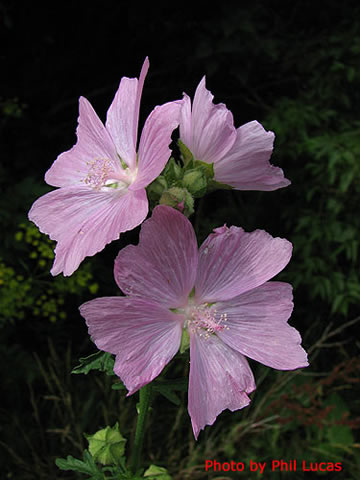The basal leaves are suborbicular (about 35mm wide by 25 mm long). They are 5-angled, 5-nerved and cordate at the base, with crenate and ciliate margins. The leaf surfaces are smooth. The floral leaves are a little larger, and tend towards being as long as wide, or slightly longer than wide. They are deeply and finely dissected into pinnatifid and doubly pinnatifid lobes. Intermediate leaves can be found at the base of flowering shoots. These show the development of deep sinuses between the 5 sectors of the leaf, and to a lesser degree between the teeth. The stipules are green, about ¼" long, lanceolate in shape, and with a fringe of ciliate hairs.
The flowers are borne singly in the axis of leaves, or in a dense terminal bracteate raceme. There can be multiple bracts and flowers (not necessarily the same number) at a node. The immature inflorescence is initially corymbose (all the buds at the same height). It then extends vertically, the outer (lower) flowers opening first. They are composed of an epicalyx of 3 bracteoles, a calyx of 5 sepals, a corolla of 5 petals, an androecium and a gynoecium of a single pistil and style, and are about 2" across. The sepals are ovate, and fused for approaching half their length. The petals are white, about 1" long, broadest towards the apex, which is irregular and generally somewhat bilobed. They have about 9 veins, which are not of a constrasting colour to the ground of the petal. The base (claw) of the petal may be white or may be a pale pink.
The stamens are fused into a staminal column. This is white, and about 10 mm long. It bears filaments along the top two-thirds of its length, each white filament being top by a pale pink anther. The pollen grains are white. The style is white. It is about 1 cm long, and surmounted by about 15 style arms of about the same length. These may be white, pink, or red; in the last two cases the colour is more intense when the style arms first extend beyond the staminal column. The stigmas are filiform, occupying much of the inner surface of the style arms.

From Plants for a Future
The musk mallow is one of our main salad plants from mid spring to mid summer. The leaves have a very mild flavour and very little fibre - they make an excellent bulk ingredient of salads. The texture might seem a bit strange to people who are unused to it, there is a distinct gummyness and this becomes an unpleasant sliminess if the leaves are cooked. However, I have hardy met anyone who finds the gummyness of the raw leaf unpleasant, indeed this gummyness is a positive attribute of the plant since it acts as a very effective balancer to the digestive system. If you have diarrhoea then the mallow leaves will soothe the digestive tract and help to stop the diarrhoea. If you are constipated then the leaves will provide the bulk that will bring about normal motions. In addition eating the leaves also helps to soothe a dry throat and chesty coughs. Established plants can be harvested quite severely and this will tend to delay their flowering, thus extending their period of use in salads. Eventually the plants will insist on flowering and then we simply move from eating the leaves to eating the flowers. These have a similar mild flavour and slightly gummy texture with a delicate sweetness.
 Musk Mallow
Musk Mallow